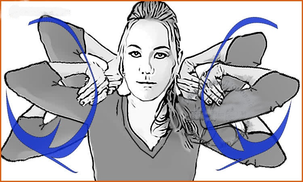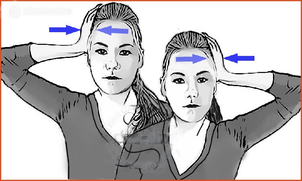There were times when the disease was considered "age-related", but recently the disease has been more frequently diagnosed with "osteochondrosis" for up to 35 years. This is due to the changing rhythm of life - more people are engaged in inactive and inactive work. And most importantly, physical activity, decreased flexibility and, thus, impaired blood circulation, which is a key factor in the nutrition and recovery of spinal discs.
Interesting fact: according to statistics, more than 80% of the population, after 30 years, experience changes in spinal space, to a greater or lesser degree.
Reason
Osteochondrosis is a common name for aging of the spine. The process is directly related to changes in the structure of the vertebrae and discs. Under the influence of internal and external factors, disk thinning occurs. Appears - protrusion, hernia, instability of the vertebrae, changes in bone tissue, appearance of osteophytes (thorns, growths). And all these phenomena are complications of osteochondrosis. This course is chronic and in the absence of complicated therapy makes it difficult to lead a normal life.
You may be familiar with the factors that drive dystrophy changes, but we note again:
- Hypodynamia - it contributes to circulatory disorders in the neck, weakening the muscle corset.
- Curvature of the spine (stoop, lordosis, kyphosis, scoliosis).
- Long stays in static position, and vice versa - load increase and load lift.
- Injuries.
- Overweight, pregnancy.
- Hereditary, metabolic disorders.
Humans are the only creatures on the planet that are prone to spinal problems in the cervical spine. This is due to our ability to walk completely upright, as well as great muscle weakness and neck movement.
An important role in the formation of cervical osteochondrosis has hereditary predisposition. Moreover, relatives do not have to suffer from osteochondrosis. Risk zones include people with a family history of degenerative diseases and dystrophy of the osteoarticular system (arthrosis, spondylitis, hernias, etc. ).
The neck is an important link. Many channels and nerves pass through it to the brain. Problems in this part of the body will certainly affect the blood circulation in the brain and the work of the upper body - shoulders, arms. Degeneration develops gradually, with increasing.
Stages of cervical osteochondrosis
In the first stage, there is a local pain syndrome, accompanied by a sharp strain on the muscles, which increases the already unpleasant sensation, restraining movement.
Pain is expressed in 2 forms:
- Cervicago - "lumbago neck", a sharp, sharp pain that appears when moving.
- Cervicalgia - painful, painful, with constant muscle tension. It can take more than two weeks, even with proper treatment.
In the second stage, "radicular" syndrome is added - nerve compression due to thinning of ligaments and discs. Pain appears when sneezing, coughing. If the patient lies on his back and moves his head passively, a painful sensation will appear.
Numbness in the hands from the neck to the fingertips is a special feature, especially after sleep. Symptoms quickly disappear after active movement or placing the hand behind the head. If numbness or pain persists, complications (protrusion, hernia) may form.
Also, there may be a feeling of "frozen" shoulder with the onset of "shoulder-hand" syndrome - when shoulder and hand arthritis begins due to circulatory disorders in osteochondrosis.
Main symptoms
The main symptoms of cervical spine osteochondrosis include:
- Headache and dizziness.
- Local pain, and irradiation that may occur to the shoulder, occiput or scapula (especially the extension of the cervicothorax region).
- Numbness and weakness in the arms.
- A lump in my throat.
- Arterial hypertension (persistent high blood pressure).
- Decreased hearing and visual acuity, tinnitus (development of vertebral artery syndrome).
Interesting: changes in the disease affect important channels in the neck that supply blood to the brain. Patients with chondrosis may experience "Chapel Sistine" syndrome - fainting after a sharp back.
Pain and localization are often disguised as a serious illness - angina pectoris.
Diagnostics and treatment
It is very important to treat the symptoms of osteochondrosis of the cervical spine at the beginning of the degenerative process. To do this, you should immediately seek help from a neurologist or vertebrologist. But exercise shows that they ask for help, which is already experiencing complications - protrusions, hernias, vertebral body instability.
Patients should be carefully examined - ultrasound of the heart, blood vessels of the brain and neck, EKG, collecting urine and blood tests. It is important that X-rays are taken, and in some projections and in an arrangement with the mouth open (to see the vertebrae that cover the teeth).
Unfortunately, doctors under the diagnosis of osteochondrosis adjust many diseases, because there is no time, experience, desire to identify the cause of these or that symptoms. Prescribed treatments that bring temporary relief, but the actual cause remains undetectable, eventually everything comes back again or does not bring any relief at all. It is this condition that makes people heal themselves.
Treatment of cervical spine osteochondrosis
Therapy should be as complete as possible.
- Physiotherapy.
- Drug therapy.
- Sort.
- Physiotherapy.
- Stretching.
- Stretching of the cervical spine according to the Shishonin method.
- Habit of stopping.
Physiotherapy
The effectiveness of the treatment of osteochondrosis of the neck of the spine with the help of physiotherapy baths and therapy has been scientifically proven.
- They relieve pain syndrome.
- Eliminates inflammation.
- Increase the effectiveness of drug therapy and other methods of treating cervical osteochondrosis.
The effects of physiotherapy therapy are enhanced in the form of low-frequency pulsed electromagnetic therapy in combination with radon baths, sometimes with iodine-bromine baths.
Drug therapy
If there are complications of osteochondrosis in the cervical spine, hernias or large protrusions, there is inflammation of the compressed nerve root. Therefore, to relieve the symptoms of inflammation and stop the pain, you need to penetrate intramuscular vitamin injections - B1, B6, B12. Also, with impaired blood circulation, blood viscosity increases, which interferes with the blood supply to the brain with oxygen. Need to take antiplatelet agent.
Drug therapy.
- Relieves pain and inflammation.
- Accelerates metabolism in tissues that are disrupted due to disrupted blood supply.
- Thin the blood, improve blood circulation.
Sort
Neck area massage courses are definitely included in the neck osteochondrosis treatment program.
- Muscle tension relaxes, thus releasing nearby arteries.
- Improves blood circulation and tissue nutrition, which has a positive effect on the heart and brain.
- Muscle pain is reduced.
Unfortunately, a good massage is not done for free and many reject this procedure because of its high price. But in medical complexes, cervical spine massage must be included for the good of the case. Although they advise that physiotherapy training is not necessary.
Physiotherapy training
Treatment of osteochondrosis with physical therapy of the cervical spine is the main method, without which recovery is not possible. No pill can cure osteochondrosis without exercise therapy. Follow the fact that you need to do gymnastics every day for a year to forget about the symptoms of this disease forever.
Important: Exercise therapy is a 70% victory over osteochondrosis. Although the pain is gone, the pain is not gone anywhere. You can not rest.
Goals and objectives of exercise therapy.
- Strengthens the deep neck muscles and corset muscles in the shoulder area, so that the muscles hold the head in the correct position, without pressure on the intervertebral disc, and no protrusions are formed that press on the nerve endings. To increase the intervertebral space, thereby eliminating nerve root compression.
- Restores painless movement while developing flexibility and mobility.
- Exercise speeds up and improves blood circulation, thereby improving the nutrition of the intervertebral disc and surrounding muscles.
Important: train yourself to do a set of exercises 3 times a day for the first 4 weeks, then 1 time a day for a year.
Neck Exercises
Before exercising, you need to warm up your muscles.
Heating
Warms the chest muscles and cervical spine. Slow circular movement with shoulders - back and forth. Every muscle should work as much as possible.

Round movement with shoulders - lift as much as possible, move back, down and then forward. While pulling back, we joined the shoulder blades. And the same circle with each shoulder alternately.
Add an arm - and repeat the movement with the arm bent at the elbow. One by one, we will reunite the shoulder blades while pulling our hands backwards. And then we will also move the shoulder forward as much as possible.
This concludes heating. Let’s start with some basic neck exercises.
Exercise techniques
Perform all movements slowly, so as not to endanger yourself and prevent pinching nerves.
Assume proper body posture. Shoulders down, slightly lying down, chin parallel to the floor. Static training aims to train deep neck muscles. Each movement withstands resistance for 5-8 seconds. Loosen for two seconds and repeat. So 5 times.
- We press the palm of the hand to the temple and press on it to bend the head, we hold it with the head, thus preventing the hand from deviating the head to the side. Do the same on the other side.
- Place your hands on the lock, support your chin and press the restraining head.
- We oppose with a forehead.
- From the back of the head
- Alternately head to the opposite side of the cheekbones

Along with strengthening the neck muscles, you also need to strengthen the shoulder belt simultaneously. Some exercises with the traveler must be included in the treatment complex 2-3 times a week.
Additional load
Exercise in the form of running, brisk walking, swimming, aerobics will improve the blood circulation of the whole body. Especially from lack of blood supply, the brain suffers, which needs oxygen for cervical spine problems. Exercise lasts at least 20-30 minutes, up to 2 times a week.
The dry attraction of the cervical spine
The dry stretching method is horizontal and vertical. This method is called traction - a very effective treatment for osteochondrosis of the spine. Young people easily get full recovery, using only one attraction during treatment. Because disk recovery at a young age is much faster. Of course, age prevents recovery and the ability to restore cartilage tissue, but traction still remains an important point in the complex treatment of neck osteochondrosis.
Stretching Problems
- Increases the lumen between the vertebrae.
- Relieves pain due to nerve root compression.
This procedure has contraindications, so do not do it without consulting your doctor. Previously, this method was only performed in hospitals, sanatoriums, and rehabilitation centers.

Stretching techniques are now available at home using treatment collars. The attraction session lasts for 15 minutes a day.
We have analyzed the entire treatment program for the cervical spine, still need to talk about the normal way of life, which should also change in perfect order.
Important: all of the above methods should be discussed with your doctor.
Habit of stopping
We understand that laziness and reason lead to early osteochondrosis. If you do not handle this, then you do not need this article. Take painkillers and live as before. Although you can try to improve some bad habits.
- Sleep on pillows and orthopedic mattresses.
- Do not lie on a high pillow for hours, when your head is raised high while reading, playing on the phone. At this point, the cervical vertebrae press on the blood vessels, interfering with blood circulation.
- Posture of a computer that does not move when there is no control over time. Set your alarm clock every hour to warm up your stiff neck muscles.
- Move more - play sports, work out, walk 10, 000 steps a day.
Summarize
Course procedures - injections, massage and physiotherapy are done 1 month every six months. During this period, physiotherapy training increased to 3 times a day.
In other months every day:
- Exercise therapy - 1 time a day.
- Stretching.
Repeat the procedure after 5 months. And this rate is at least a year. Positive results can be seen within a month.
The above technique is not an algorithm for all cases of cervical osteochondrosis treatment. All matters should be discussed with the doctor. But if the doctor prescribes only one method, for example, physiotherapy, massage, then the effect will be temporary. The treatment is long, so it is better to immediately follow the recovery success. Believe me, you will never go back to your old way of life by starting to practice and feel relieved.
How cervical osteochondrosis is treated
Several groups of drugs are prescribed for the treatment of basic medicines.
- Painkillers are prescribed in tablets, or for severe pain, novocaine blockers.
- Nonsteroidal anti-inflammatory drugs - Nurofen, Diclofenac.
- Annoying ointment - finalgon, capsicam.
- Preparations to relax the neck muscles - relax the muscles.
- Intramuscular vitamin B injection course
Support using current, massage, heating (placing cans, mustard plaster) is prescribed during the period of major pain syndrome. During periods of exacerbation, pain is always present, to relieve them, as well as muscle tension, the exercise therapy complex shown above is performed, apply an approximate pepper plaster.
Important: any exercise with head rotation is prohibited in the event of vertebral artery syndrome, when the cervix is constricted due to osteochondrosis.
At home, it is effective to take a relaxing bath by boiling herbs, compresses and scrubs (for example, using propolis, aloe vera). Russian baths can relieve muscle tension. Traditional steam rooms with swipes can relax, reduce pain, and cheer.
In extreme cases, it is necessary to perform surgical intervention, when there is a danger of complications due to compression can cause disability. Namely - complete compression of blood vessels or nerves, significant osteophyte growth or the appearance of hernial protrusions. The operation is performed according to all the rules of nerve surgery - under a microscope and with minimal incision.





































